|

Photo: FAO/FIS
Globefish report on the global bivalves market
 WORLDWIDE WORLDWIDE
Friday, July 19, 2024, 07:00 (GMT + 9)
The following is an excerpt from a report published by Globefish (FAO):
Bivalve demand strong
Supply of bivalves improved slightly in 2023 over 2022, but stayed far below the 2021 level. Further shortage of supplies may occur in 2024 due to sanitary problems in France and Peru, together with increased domestic demand in China. Prices may rise, depending on the season.
Mussels
To talk about mussels is probably to highlight one of the most popular foods in the world, as it lends itself to being cooked in about a thousand ways. In Spain, it is the most consumed seafood, with consumption per capita being an average of 1.13 kg of mussels per year, according to the Report on Food Consumption in Spain prepared by the Ministry of Agriculture. Comprising proteins, some 87 percent of water and only 1.9 percent fat, mussels are, like almost all seafood, a healthy food choice. They also provide iron (in higher proportions than even many meats per 100g serving), phosphorus and iodine.
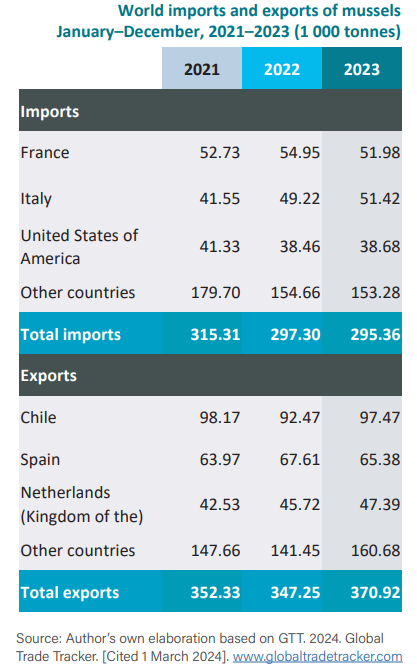

Click image to enlarge it
The mussel season in Spain is slow during the spawning season from May to August when the females lose weight. Needless to say, therefore, that the months from September to April are ideal for tasting this type of mollusc, since it is meatier than at other times of the year. Spain is the main mussel producer in Europe with about 200,000 tonnes produced per year, mainly in the Galicia region.

Click image to enlarge it
In 2022, global imports of mussels were on the low side at about 300 000 tonnes. France and Italy were the main importing countries with 51,000 tonnes each, while the United States imported about 38 000 tonnes, substantially less compared with 2021. On the other hand, exports went up in 2022; Chile was the main mussel exporter, reporting a return to the 2021 export levels of about 100,000 tonnes. The Kingdom of the Netherlands also continued the positive trend started in 2021 with some 47 000 tonnes sold overseas, 5 000 tonnes more than in 2021.
Oysters
 Some 85,000 tonnes of oysters entered international trade in 2023, down by seven percent over 2022. The United States continued to be the biggest market, but was nevertheless the main reason for the decline. Shrimp and oysters suffered last year from the general reluctance of the US consumer to spend on more expensive food items, a reaction to high inflation rates and general uncertainty in the market. Some 85,000 tonnes of oysters entered international trade in 2023, down by seven percent over 2022. The United States continued to be the biggest market, but was nevertheless the main reason for the decline. Shrimp and oysters suffered last year from the general reluctance of the US consumer to spend on more expensive food items, a reaction to high inflation rates and general uncertainty in the market.
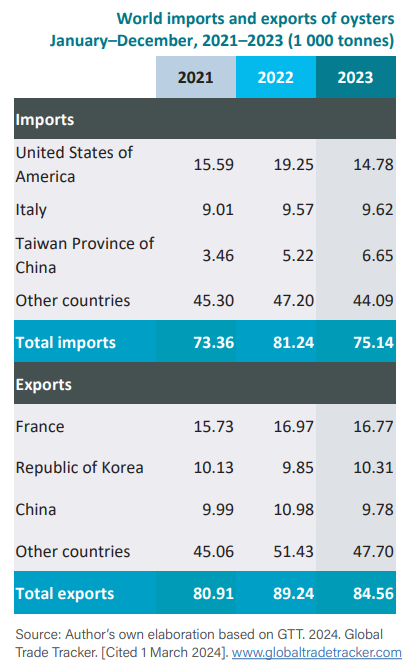
Perceived abroad as a “luxury product”, French oysters have a steady market. Nearly 16,700 tonnes were exported last year, just 200 tonnes short of the 2022 volume. France is the fifth largest global producer of oysters, but at the same time, it is the world’s largest exporter. The region of Charente-Maritime is clearly doing well among local oyster producers as more than 80 percent of the oysters exported from France come from the island of Oléron and the Marennes basin. However, in early 2024, several production areas were closed in France due to a health scare caused by the presence of norovirus in the oysters.
Scallops
 World scallop trade, which is mainly in the hands of Chinese producers, experienced a substantial decline last year; in 2022, China had imported some 100 000 tonnes of scallops which dropped to 54,600 tonnes in 2023. Chinese exports also declined (by 4,000 tonnes) from the 2022 level to 37 000 tonnes in 2023. Similarly, Peru, which had experienced a boom in scallop production in 2021, continued to experience some setbacks in 2023. Some 4,500 tonnes were exported last year, which is less than half of the 2021 amount. World scallop trade, which is mainly in the hands of Chinese producers, experienced a substantial decline last year; in 2022, China had imported some 100 000 tonnes of scallops which dropped to 54,600 tonnes in 2023. Chinese exports also declined (by 4,000 tonnes) from the 2022 level to 37 000 tonnes in 2023. Similarly, Peru, which had experienced a boom in scallop production in 2021, continued to experience some setbacks in 2023. Some 4,500 tonnes were exported last year, which is less than half of the 2021 amount.
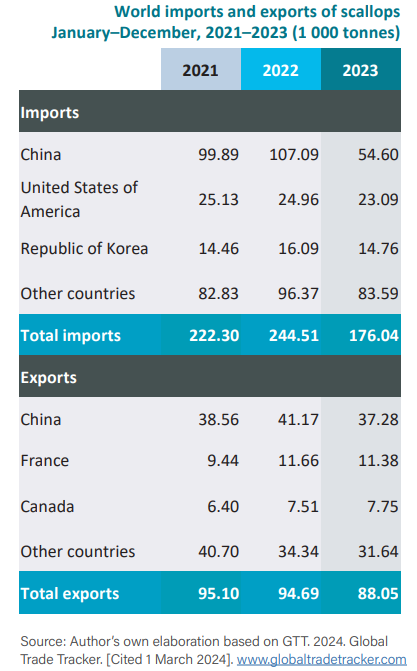
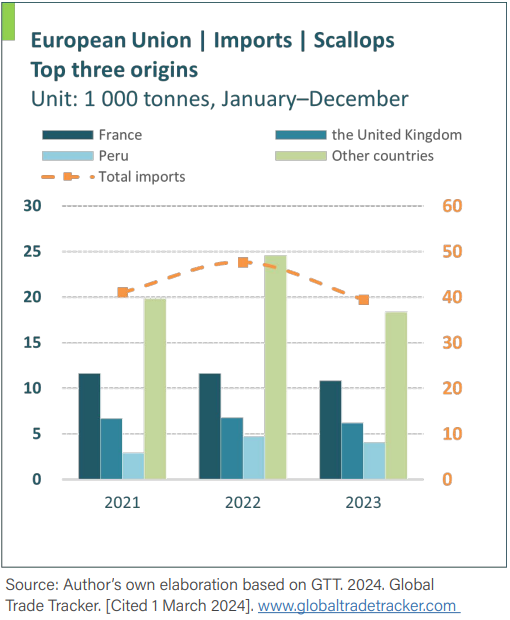
The setback in Peruvian scallop production is linked to sanitary problems. Ministerio de la Producción/The Ministry of Production (PRODUCE), through the Organismo Nacional de Sanidad Perquera/National Fisheries Health Agency (SANIPES), has issued an urgent call to the country’s aquaculture producers to comply with current regulations and maintain the sanitary classification of bivalve mollusc production areas. This measure is crucial in order for the sector to continue marketing its production in the domestic market and exporting to various destinations. Infractions include noncompliance in the number of samplings, and unsatisfactory sampling and analysis for sanitary criteria; as well as incorrect or falsified information on the origin of bivalve molluscs. Likewise, the lack of availability of bivalve molluscs for sampling, and the prohibition or restriction of extraction in the production area for reasons unrelated to public health, are considered grounds for withdrawal of the sanitary classification.
Clams
China is the world’s main producer and exporter of clams, but the country experienced a significant decline in shipments in recent years; for instance, some 113,000 tonnes of clams were exported by China in 2023, 22 percent less than in 2021. This was mainly caused by strong domestic demand, with local consumers willing to pay higher prices for clams than the main importing countries, namely the Republic of Korea and Japan.
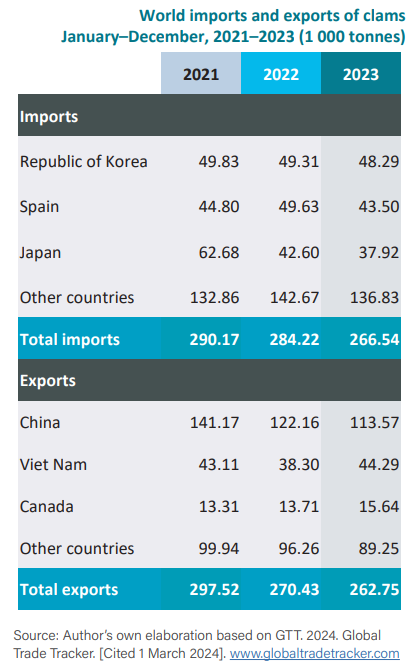
As a result, Japanese imports of clams were almost halved between 2021 and 2023 to 38,000 tonnes. . The Republic of Korea, on the other hand, reported stable imports at about 48,000 tonnes, becoming the top clam-importing country in the world. Spain was in second place, despite a 15 percent reduction in imports between 2022 and 2023.
Outlook
Bivalve prices are rising in all major markets, both as a result of strong demand and declining production. The coming summer period is likely to be a period of high consumption, especially in North America and Europe, which should result in further price increases. As bivalve growing is subject to climate changes, reductions in supply are likely to emerge during the year, especially in Italy, one of the world’s major producing areas.
Source: FAO-Globefish
[email protected]
www.seafood.media
|



